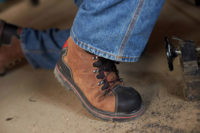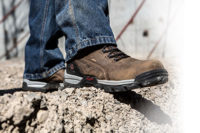Lighten up
Advanced materials make boots flexible, lightweight & durable

Upper materials
As early as 20 years ago, synthetic materials were rarely found in work boots. The recent trend toward work boots that look and feel more like athletic footwear, coupled with the increased performance and value of synthetics, has challenged leather’s virtual dominance in the work boot market. Made from an ever-increasing variety of man-made fibers and resins, most synthetic materials (including leather that is synthetically enhanced) are more lightweight than leather, and can be more durable and readily formulated to be waterproof. Footwear that has synthetic upper materials are usually designed to be lightweight and feel more like a sport shoe, while maintaining the durability of a more traditional work boot. For the millions of people who grew up wearing sneakers, a work boot that looks and feels more like a sport shoe is a natural choice. Thanks to advances in the development of man-made materials, they have many more affordable options to choose from.
Although synthetics are making a name for themselves in the work footwear market, leather is undoubtedly the tried and true upper material found in many work boots — and for good reason. Leather is breathable and a good choice for people who are on their feet for hours at a time. Leather provides a customized fit for each individual because leather molds to the foot with wear. And leather is by nature quite durable.
In order to leverage the advantages of both of these materials, boots that combine leather and man-made materials are becoming more common. Uppers with complementing leather and synthetic components can be designed in a more traditional work boot fashion, or more like a sport shoe. In either fashion, combining leather and synthetic can result in a lightweight, breathable and flexible upper that embodies the best properties of both kinds of materials.
Outsole materials
When it comes to outsoles, genuine rubber is still the most common material used. The reason is simple enough: rubber offers excellent performance in terms of abrasion, oil- and slip-resistant qualities that are needed in a work boot where durability and performance are critical.
The main advantage to newer alternative materials like TPU (thermoplastic polyurethane), PU (polyurethane) and EVA (Ethel-Vinyl-Acetate) is that they are all lighter in weight, more flexible and, in the case of PU and EVA, provide greater cushioning. Many modern work boots offer combinations of these synthetic materials as well as rubber. Moreover, advances in chemistry and chemical engineering have allowed boot developers to fine-tune the performance characteristics of outsoles so that there is a more focused match between outsole performance and function or customer preference.
Toe-caps
A steel cap has been and remains the mainstay of all kinds of footwear that require safety toes. When it comes to protecting the toe area from a sudden blow (like a heavy box falling) or a protracted compression (toes pinned under a heavy pallet), there are few affordable materials that can meet, let alone exceed, the strength, resilience and elasticity of steel. It remains the safety toe of choice for most people.
Safety caps that are forged from aluminum alloys or thermo-formed from resins and fiberglass composites are, however, challenging the dominance of the steel cap. These new options respond to the one drawback of steel caps: although they are durable and dependable, they are comparatively heavy. Aluminum and composite caps can be significantly lighter than comparable steel caps. However, there are drawbacks to these lighter options. In order to meet the performance standards of steel, these non-steel alternatives have to be made bigger and thicker. This can make the shoes look bigger in the toe and can create challenges to a proper and comfortable fit. Aluminum and composite toes are also more expensive than steel. However, with improvements in the cost and performance of non-steel caps (especially in composite caps), the trend away from steel is growing and gaining momentum.
What’s best for you?
Tried and true materials — leather, rubber and steel — have earned their solid reputation in the work footwear market with years of proven performance. However, their new challengers — synthetics, PU/TPU/EVA and composite/aluminum — offer their own set of advantages. What’s best depends on individual safety and comfort needs; the best may be a combination that leverages the best characteristics of each material.
Looking for a reprint of this article?
From high-res PDFs to custom plaques, order your copy today!






